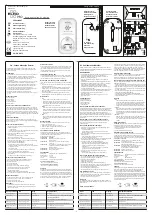
Feature #3 Automatic Rearming
Factory Default Setting
Off
(
press
“arm/lock” button to program
)
Options:
On without doors locking
(
press
“disarm/unlock” button to program
)
On with doors locking
(
press
“
II
” button to program
)
“Automatic Rearming” prevents the system from becoming accidentally disarmed
by having it arm itself after being disarmed, if a door is not then opened or the
ignition turned on. Options are to have Automatic Rearming operate with or without
also locking the doors when the system does rearm.
Feature #4 Starter Interrupt Functions
Factory Default Setting
On
(
press
“arm/lock” button to program
)
Options:
Off
(
press
“disarm/unlock” button to program
)
Automatic
(
press
“
II
” button to program
)
This feature controls the Starter Interrupt circuit, in several ways. In its default
setting, “On”, the Starter Interrupt is operable whenever the alarm is armed.
The “Automatic” option will cause the Starter Interrupt output to automati-
cally engage 90 seconds after the ignition switch is turned "off", and also 90 sec-
onds after disarming the system. This automatic engagement will occur even if the
security system is in a disarmed state, but not if it is in Valet Mode. Once the
Starter Interrupt output is activated, the system must be armed, then disarmed with
the controller or transmitter, or placed into the Valet Mode by pressing and holding
the Valet Switch for 2 seconds to disengage it. There are no Status Light indica-
tions with this automatic form of Starter Interrupt.
Programming this feature “Off” completely eliminates the Starter Interrupt
output, while leaving all other system operations fully functional.
Feature #5 Ignition Activated Override
Factory Default Setting
Off (
press
“disarm/unlock” button to program
)
Option:
On (
press
“arm/lock” button to program
)
This feature allows an activated system to be overridden and disarmed by simply
turning th
e i
gnition switch on within 10 seconds of the system’s activation. After
10 seconds, the Emergency Override must be performed or the controller or trans-
mitter “disarm/unlock” button can be used to disarm the system.
Page - 25
Feature #6 Doors Lock With Ignition On
Factory Default Setting
On (
press
“arm/lock” button to program
)
Option:
Off (
press
“disarm/unlock” button to program
)
This feature configures the system to automatically lock the vehicle’s doors every
Page - 12
The correct wire for a Positive switching type of dome light/door jamb pin
switch system will have 12 volts present when the doors are opened, and chassis
ground when the doors are closed.
CONNECTION:
Connect the Violet wire to a wire in the vehicle that is
common to all the door pin switches; the correct wire for this type of dome light/door
jamb pin switch system will have 12 volts present when the doors are opened, and
chassis ground when the doors are closed.
Notes and Tips, both types of Interior Light or Door Trigger
circuits:
The correct wire will show this change when any of the doors are
opened. If the vehicle has delay-off or “fade away” interior lights, remember
to take this into account when testing the wire. If the pin switch is mounted in
the metal structure of the vehicle, and the interior lighting goes out when the
switch is removed, suspect a grounding switch-type lighting system.
Switches controlling interior lighting may be found in several locations-
the front or rear door jamb area, as the traditional “pin switch” or sliding
switch; or as switches inside the doors, either connected to the exterior door
handles or to the latching mechanism. A vehicle which has the interior lights
illuminating when the outside door handle is lifted is an example of this type
of switching system.
Also be aware of vehicles which diode-isolate each door. Typically, this
is usually encountered with dash displays that indicate individual doors being
ajar. The proper wire to connect to in this type of system is the common wire
which is routed directly to an interior light that illuminates when any door is
opened.
Green/Violet - (Domelight Supervision Output) &
Black/Red - (Domelight Supervision Input) Wires:
Domelight Supervision offers an additional safety and security feature- upon
disarming the system the interior lights will turn on to illuminate the interior. The
Green/Violet wire is the output to turn on the lights, and the Black/Red wire is
input, connected to Positive or Negative polarity which is needed for operating the
interior light.
For reference, see the diagrams on the previous page 11 showing the basic
differences between Negative and Positive interior light circuits.
CONNECTION GREEN/VIOLET:
The proper vehicle wire to connect the
Green/Violet wire to, the dome light activation wire, is common to all the door pin
switches. The correct wire will change polarity as the doors are opened and closed.
The dome light activation wire in the vehicle is typically the same wire that the




































